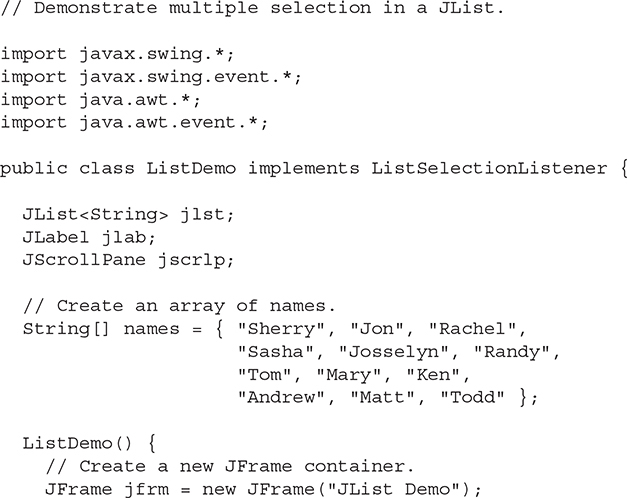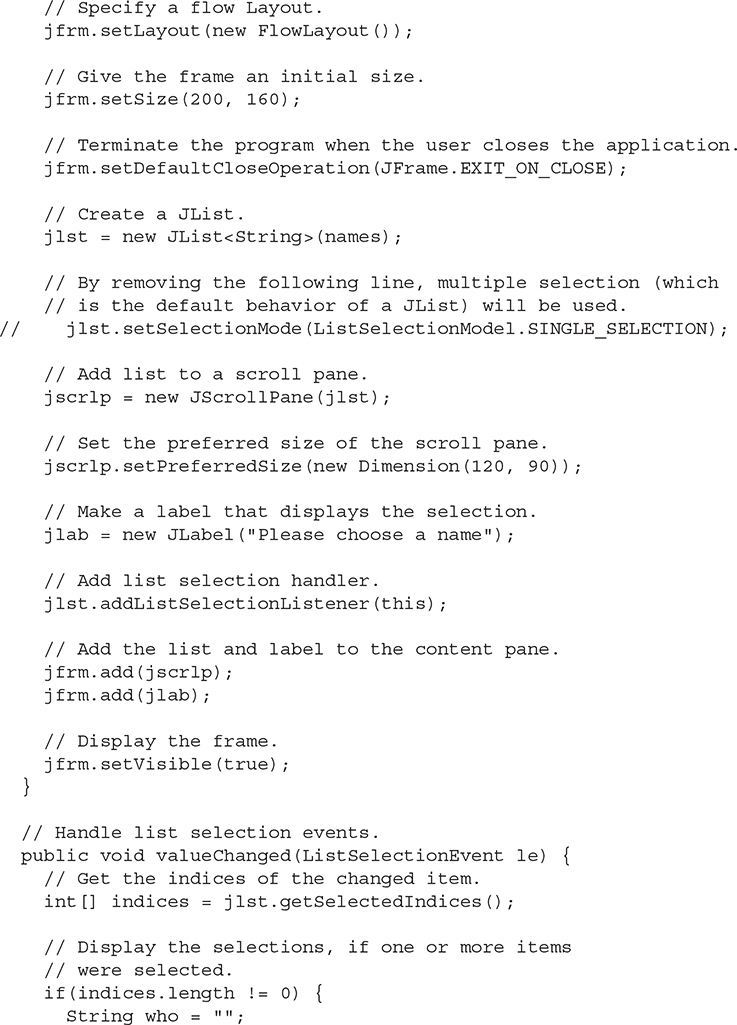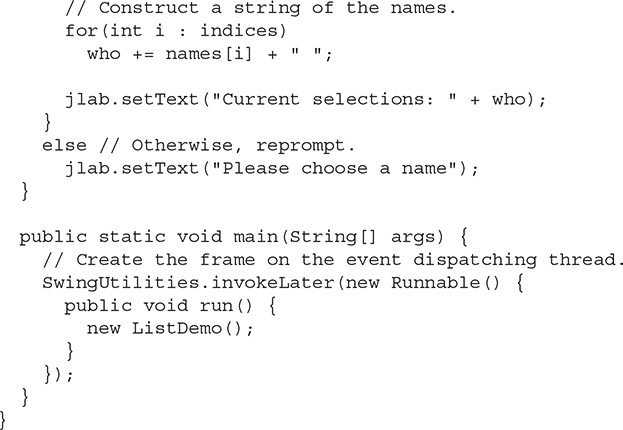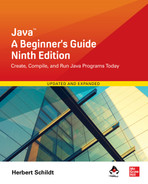Appendix A
Answers to Self Tests

Chapter 1: Java Fundamentals
1. What is bytecode and why is it important to Java’s use for Internet programming?
Bytecode is a highly optimized set of instructions that is executed by the Java Virtual Machine.
Bytecode helps Java achieve both portability and security.
2. What are the three main principles of object-oriented programming?
Encapsulation, polymorphism, and inheritance.
3. Where do Java programs begin execution?
Java programs begin execution at main( ).
4. What is a variable?
A variable is a named memory location. The contents of a variable can be changed during the execution of a program.
5. Which of the following variable names is invalid?
The invalid variable is D. Variable names cannot begin with a digit.
6. How do you create a single-line comment? How do you create a multiline comment?
A single-line comment begins with // and ends at the end of the line. A multiline comment begins with /* and ends with */.
7. Show the general form of the if statement. Show the general form of the for loop.
The general form of the if:
if(condition) statement;
The general form of the for:
for(initialization; condition; iteration) statement;
8. How do you create a block of code?
A block of code is started with a { and ended with a }.
9. The moon’s gravity is about 17 percent that of the earth’s. Write a program that computes your effective weight on the moon.
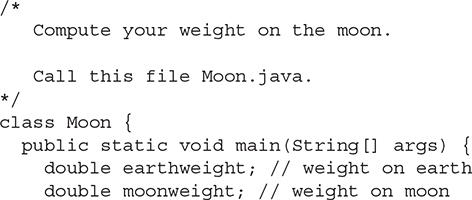
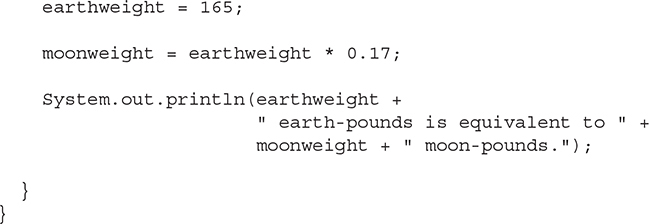
10. Adapt Try This 1-2 so that it prints a conversion table of inches to meters. Display 12 feet of conversions, inch by inch. Output a blank line every 12 inches. (One meter equals approximately 39.37 inches.)

11. If you make a typing mistake when entering your program, what sort of error will result?
A syntax error.
12. Does it matter where on a line you put a statement?
No, Java is a free-form language.
Chapter 2: Introducing Data Types and Operators
1. Why does Java strictly specify the range and behavior of its primitive types?
Java strictly specifies the range and behavior of its primitive types to ensure portability across platforms.
2. What is Java’s character type, and how does it differ from the character type used by some other programming languages?
Java’s character type is char. Java characters are Unicode rather than ASCII, which is used by some other computer languages.
3. A boolean value can have any value you like because any non-zero value is true. True or False?
False. A boolean value must be either true or false.
4. Given this output,

use a single string to show the println( ) statement that produced it.
![]()
5. What is wrong with this fragment?

There are two fundamental flaws in the fragment. First, sum is created each time the block defined by the for loop is entered and destroyed on exit. Thus, it will not hold its value between iterations. Attempting to use sum to hold a running sum of the iterations is pointless. Second, sum will not be known outside of the block in which it is declared. Thus, the reference to it in the println( ) statement is invalid.
6. Explain the difference between the prefix and postfix forms of the increment operator.
When the increment operator precedes its operand, Java will perform the increment prior to obtaining the operand’s value for use by the rest of the expression. If the operator follows its operand, then Java will obtain the operand’s value before incrementing.
7. Show how a short-circuit AND can be used to prevent a divide-by-zero error.
![]()
8. In an expression, what type are byte and short promoted to?
In an expression, byte and short are promoted to int.
9. In general, when is a cast needed?
A cast is needed when converting between incompatible types or when a narrowing conversion is occurring.
10. Write a program that finds all of the prime numbers between 2 and 100.
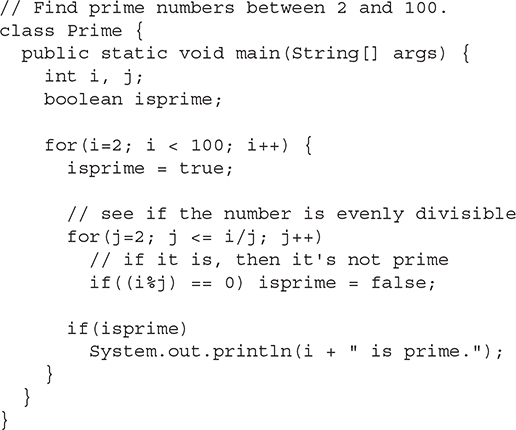
11. Does the use of redundant parentheses affect program performance?
No.
12. Does a block define a scope?
Yes.
Chapter 3: Program Control Statements
1. Write a program that reads characters from the keyboard until a period is received. Have the program count the number of spaces. Report the total at the end of the program.
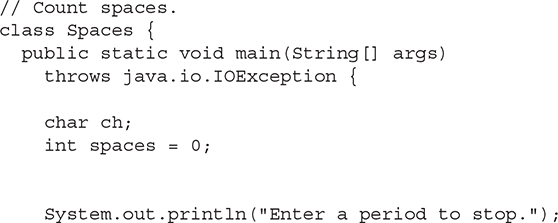
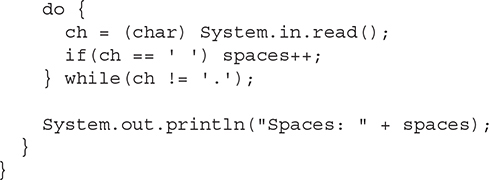
2. Show the general form of the if-else-if ladder.
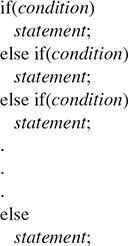
3. Given

to what if does the last else associate?
The last else associates with if(y > 100).
4. Show the for statement for a loop that counts from 1000 to 0 by −2.
![]()
5. Is the following fragment valid?

No; i is not known outside of the for loop in which it is declared.
6. Explain what break does. Be sure to explain both of its forms.
A break without a label causes termination of its immediately enclosing loop or switch statement.
A break with a label causes control to transfer to the end of the labeled block.
7. In the following fragment, after the break statement executes, what is displayed?
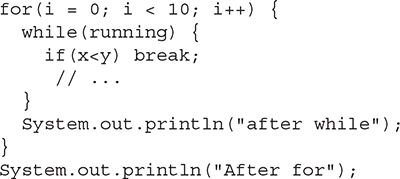
After break executes, “after while” is displayed.
8. What does the following fragment print?

Here is the answer:
![]()
9. The iteration expression in a for loop need not always alter the loop control variable by a fixed amount. Instead, the loop control variable can change in any arbitrary way. Using this concept, write a program that uses a for loop to generate and display the progression 1, 2, 4, 8, 16, 32, and so on.

10. The ASCII lowercase letters are separated from the uppercase letters by 32. Thus, to convert a lowercase letter to uppercase, subtract 32 from it. Use this information to write a program that reads characters from the keyboard. Have it convert all lowercase letters to uppercase, and all uppercase letters to lowercase, displaying the result. Make no changes to any other character. Have the program stop when the user enters a period. At the end, have the program display the number of case changes that have taken place.
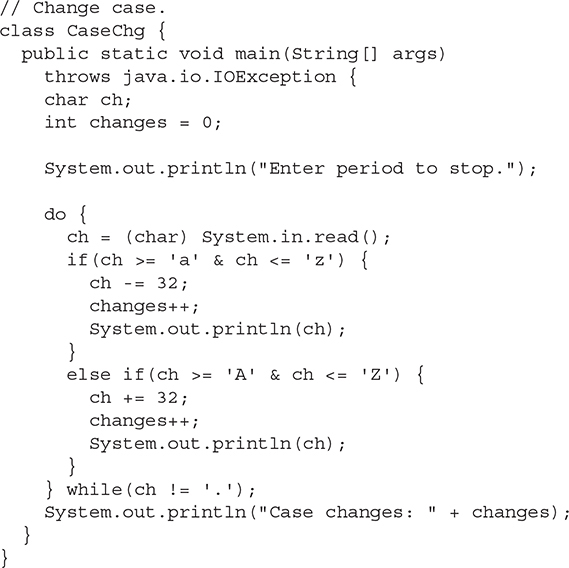
11. What is an infinite loop?
An infinite loop is a loop that runs indefinitely.
12. When using break with a label, must the label be on a block that contains the break?
Yes.
Chapter 4: Introducing Classes, Objects, and Methods
1. What is the difference between a class and an object?
A class is a logical abstraction that describes the form and behavior of an object. An object is a physical instance of the class.
2. How is a class defined?
A class is defined by using the keyword class. Inside the class statement, you specify the code and data that comprise the class.
3. What does each object have its own copy of?
Each object of a class has its own copy of the class’ instance variables.
4. Using two separate statements, show how to declare an object called counter of a class called MyCounter.
![]()
5. Show how a method called myMeth( ) is declared if it has a return type of double and has two int parameters called a and b.
![]()
6. How must a method return if it returns a value?
A method that returns a value must return via the return statement, passing back the return value in the process.
7. What name does a constructor have?
A constructor has the same name as its class.
8. What does new do?
The new operator allocates memory for an object and initializes it using the object’s constructor.
9. What is garbage collection and how does it work?
Garbage collection is the mechanism that recycles unused objects so that their memory can be reused.
10. What is this?
The this keyword is a reference to the object on which a method is invoked. It is automatically passed to a method.
11. Can a constructor have one or more parameters?
Yes.
12. If a method returns no value, what must its return type be?
void
Chapter 5: More Data Types and Operators
1. Show two ways to declare a one-dimensional array of 12 doubles.
![]()
2. Show how to initialize a one-dimensional array of integers to the values 1 through 5.
![]()
3. Write a program that uses an array to find the average of ten double values. Use any ten values you like.

4. Change the sort in Try This 5-1 so that it sorts an array of strings. Demonstrate that it works.
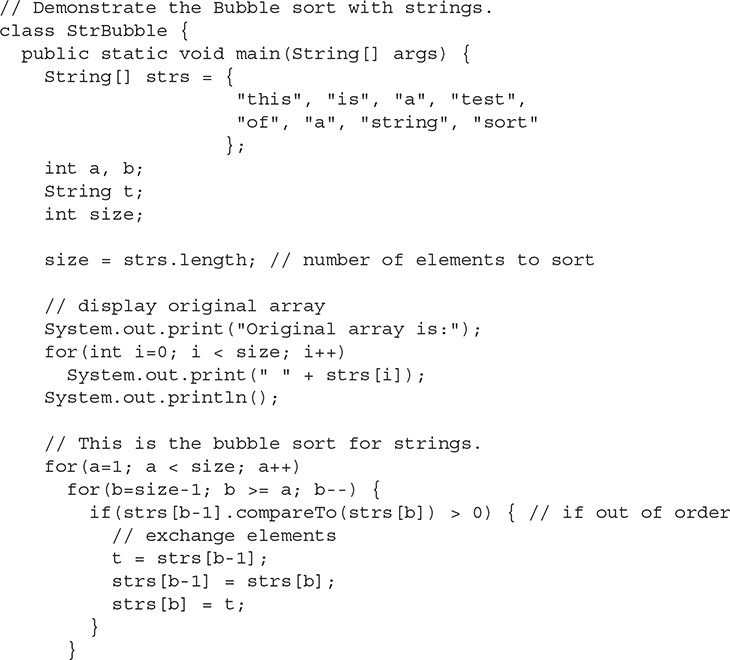
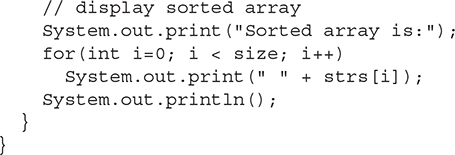
5. What is the difference between the String methods indexOf( ) and lastIndexOf( )?
The indexOf( ) method finds the first occurrence of the specified substring. lastIndexOf( ) finds the last occurrence.
6. Since all strings are objects of type String, show how you can call the length( ) and charAt( ) methods on this string literal: "I like Java".
As strange as it may look, this is a valid call to length( ):
![]()
The output displayed is 11. charAt( ) is called in a similar fashion.
7. Expanding on the Encode cipher class, modify it so that it uses an eight-character string as the key.
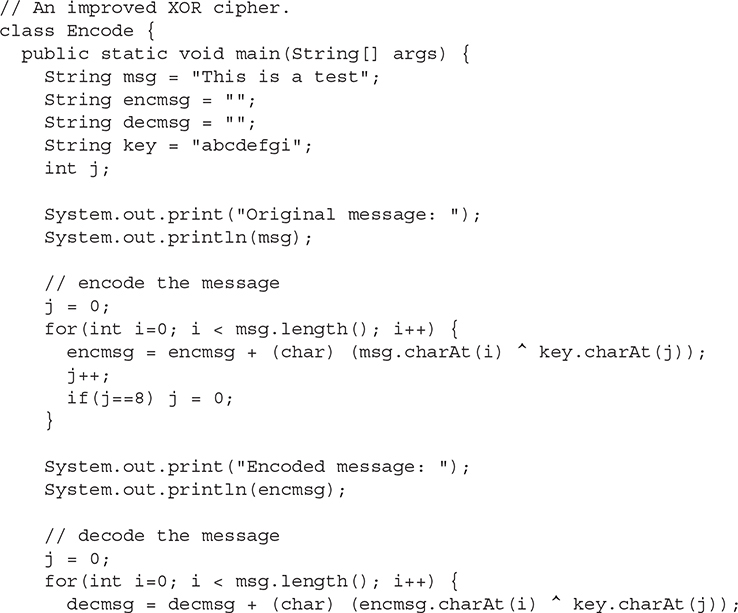

8. Can the bitwise operators be applied to the double type?
No.
9. Show how this sequence can be rewritten using the ? operator.
![]()
Here is the answer:
![]()
10. In the following fragment, is the & a bitwise or logical operator? Why?

It is a logical operator because the operands are of type boolean.
11. Is it an error to overrun the end of an array?
Yes.
Is it an error to index an array with a negative value?
Yes. All array indexes start at zero.
12. What is the unsigned right-shift operator?
>>>
13. Rewrite the MinMax class shown earlier in this chapter so that it uses a for-each style for loop.

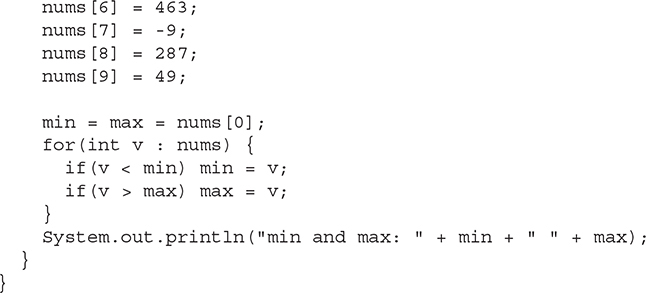
14. Can the for loops that perform sorting in the Bubble class shown in Try This 5-1 be converted into for-each style loops? If not, why not?
No, the for loops in the Bubble class that perform the sort cannot be converted into for-each style loops. In the case of the outer loop, the current value of its loop counter is needed by the inner loop. In the case of the inner loop, out-of-order values must be exchanged, which implies assignments. Assignments to the underlying array cannot take place when using a for-each style loop.
15. Can a String control a switch statement?
Yes.
16. What keyword is reserved for use with local variable type inference?
The context-sensitive keyword var is reserved for use with local variable type inference.
17. Show how to use local variable type inference to declare a boolean variable called done that has an initial value of false.
var done = false;
18. Can var be the name of a variable? Can var be the name of a class?
Yes, var can be the name of a variable. No, var cannot be the name of a class.
19. Is the following declaration valid? If not, why not.
var[] avgTemps = new double[7];
No, it is not valid because array brackets are not allowed after var. Remember, the complete type is inferred from the initializer.
20. Is the following declaration valid? If not, why not?
var alpha = 10, beta = 20;
No, only one variable at a time can be declared when type inference is used.
21. In the show( ) method of the ShowBits class developed in Try This 5-3, the local variable mask is declared as shown here:
long mask = 1;
Change this declaration so that it uses local variable type inference. When doing so, be sure that mask is of type long (as it is here), and not of type int.

Chapter 6: A Closer Look at Methods and Classes
1. Given this fragment,
![]()
is the following fragment correct?

No; a private member cannot be accessed outside of its class.
2. An access modifier must __________ a member’s declaration.
precede
3. The complement of a queue is a stack. It uses first-in, last-out accessing and is often likened to a stack of plates. The first plate put on the table is the last plate used. Create a stack class called Stack that can hold characters. Call the methods that access the stack push( ) and pop( ). Allow the user to specify the size of the stack when it is created. Keep all other members of the Stack class private. (Hint: You can use the Queue class as a model; just change the way that the data is accessed.)
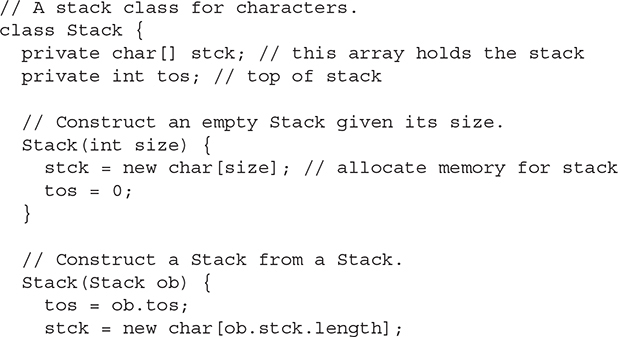
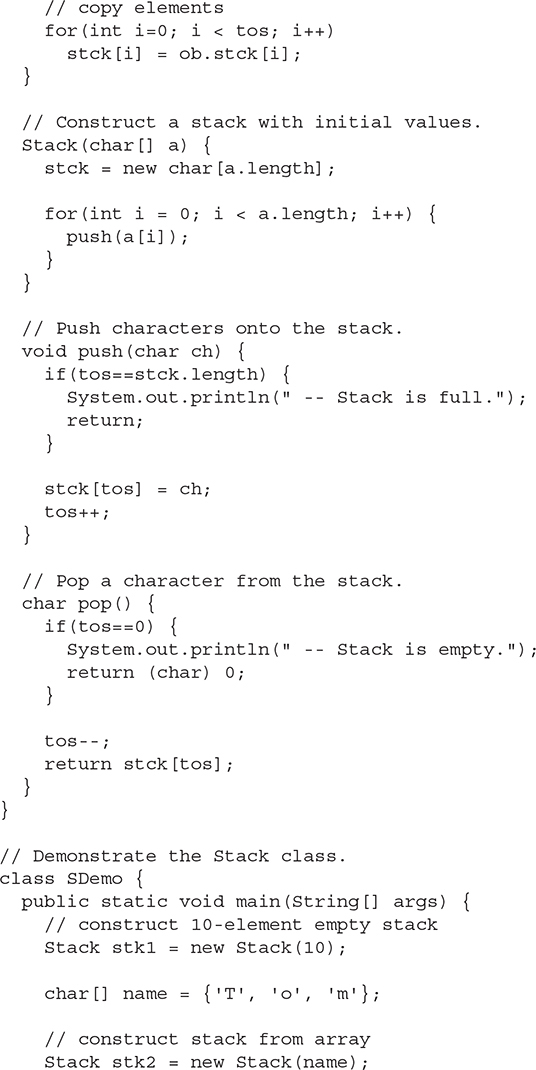
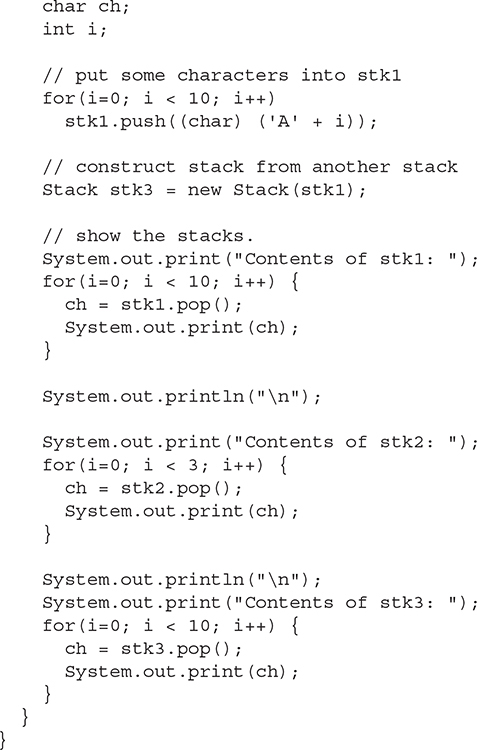
Here is the output from the program:

4. Given this class,

write a method called swap( ) that exchanges the contents of the objects referred to by two Test object references.

5. Is the following fragment correct?

No. Overloaded methods can have different return types, but they do not play a role in overload resolution. Overloaded methods must have different parameter lists.
6. Write a recursive method that displays the contents of a string backwards.

7. If all objects of a class need to share the same variable, how must you declare that variable?
Shared variables are declared as static.
8. Why might you need to use a static block?
A static block is used to perform any initializations related to the class, before any objects are created.
9. What is an inner class?
An inner class is a nonstatic nested class.
10. To make a member accessible by only other members of its class, what access modifier must be used?
private
11. The name of a method plus its parameter list constitutes the method’s __________.
signature
12. An int argument is passed to a method by using call-by-__________.
value
13. Create a varargs method called sum( ) that sums the int values passed to it. Have it return the result. Demonstrate its use.
There are many ways to craft the solution. Here is one:

14. Can a varargs method be overloaded?
Yes.
15. Show an example of an overloaded varargs method that is ambiguous.
Here is one example of an overloaded varargs method that is ambiguous:

If you try to call myMeth( ) with one argument, like this,
![]()
the compiler can’t determine which version of the method to invoke.
Chapter 7: Inheritance
1. Does a superclass have access to the members of a subclass? Does a subclass have access to the members of a superclass?
No, a superclass has no knowledge of its subclasses. Yes, a subclass has access to all nonprivate members of its superclass.
2. Create a subclass of TwoDShape called Circle. Include an area( ) method that computes the area of the circle and a constructor that uses super to initialize the TwoDShape portion.
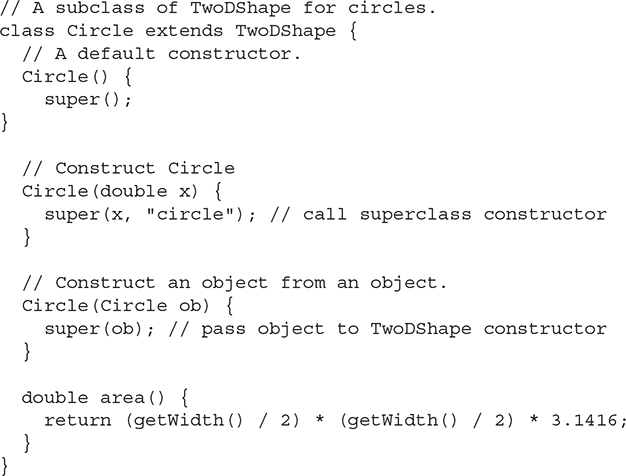
3. How do you prevent a subclass from having access to a member of a superclass?
To prevent a subclass from having access to a superclass member, declare that member as private.
4. Describe the purpose and use of the two versions of super described in this chapter.
The super keyword has two forms. The first is used to call a superclass constructor. The general form of this usage is
super (param-list);
The second form of super is used to access a superclass member. It has this general form:
super.member
5. Given the following hierarchy, in what order do the constructors for these classes complete their execution when a Gamma object is instantiated?
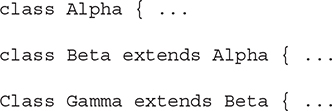
Constructors complete their execution in order of derivation. Thus, when a Gamma object is created, the order is Alpha, Beta, Gamma.
6. A superclass reference can refer to a subclass object. Explain why this is important as it is related to method overriding.
When an overridden method is called through a superclass reference, it is the type of the object being referred to that determines which version of the method is called.
7. What is an abstract class?
An abstract class contains at least one abstract method.
8. How do you prevent a method from being overridden? How do you prevent a class from being inherited?
To prevent a method from being overridden, declare it as final. To prevent a class from being inherited, declare it as final.
9. Explain how inheritance, method overriding, and abstract classes are used to support polymorphism.
Inheritance, method overriding, and abstract classes support polymorphism by enabling you to create a generalized class structure that can be implemented by a variety of classes. Thus, the abstract class defines a consistent interface that is shared by all implementing classes. This embodies the concept of “one interface, multiple methods.”
10. What class is a superclass of every other class?
The Object class.
11. A class that contains at least one abstract method must, itself, be declared abstract. True or False?
True.
12. What keyword is used to create a named constant?
final
13. Assume that class B inherits class A. Further, assume a method called makeObj( ) that is declared as shown here:

Notice that makeObj( ) returns a reference to an object of either type A or B, depending on the value of which. Notice, however, that the return type of makeObj( ) is A. (Recall that a superclass reference can refer to a subclass object.) Given this situation and assuming that you are using JDK 10 or later, what is the type of myRef in the following declaration and why?
![]()
Even though a B object is created, the type of myRef will be A because that is the declared return type of makeObj( ). When using local variable type inference, the inferred type of a variable is based on the declared type of its initializer. Therefore, if the initializer is of a superclass type (which is A in this case), that will be the type of the variable. It does not matter if the actual object being referred to by the initializer is an instance of a derived class.
14. Assuming the situation described in Question 13, what will the type of myRef be given this statement?
![]()
In this case, the cast to B specifies the type of the initializer, and myRef is of type B.
Chapter 8: Packages and Interfaces
1. Using the code from Try This 8-1, put the ICharQ interface and its three implementations into a package called qpack. Keeping the queue demonstration class IQDemo in the default package, show how to import and use the classes in qpack.
To put ICharQ and its implementations into the qpack package, you must separate each into its own file, make each implementation class public, and add this statement to the top of each file.
![]()
Once this has been done, you can use qpack by adding this import statement to IQDemo.
![]()
2. What is a namespace? Why is it important that Java allows you to partition the namespace?
A namespace is a declarative region. By partitioning the namespace, you can prevent name collisions.
3. Typically, packages are stored in __________.
directories
4. Explain the difference between protected and default access.
A member with protected access can be used within its package and by a subclass in other packages.
A member with default access can be used only within its package.
5. Explain the two ways that the members of a package can be used by other packages.
To use a member of a package, you can either fully qualify its name, or you can import it using import.
6. “One interface, multiple methods” is a key tenet of Java. What feature best exemplifies it?
The interface best exemplifies the one interface, multiple methods principle of OOP.
7. How many classes can implement an interface? How many interfaces can a class implement?
An interface can be implemented by an unlimited number of classes. A class can implement as many interfaces as it chooses.
8. Can interfaces be extended?
Yes, interfaces can be extended.
9. Create an interface for the Vehicle class from Chapter 7. Call the interface IVehicle.
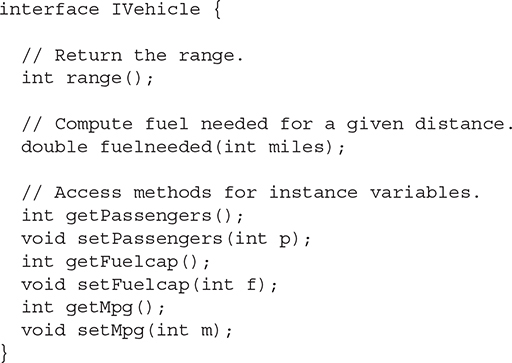
10. Variables declared in an interface are implicitly static and final. Can they be shared with other parts of a program?
Yes, interface variables can be used as named constants that are shared by all files in a program. They are brought into view by implementing their interface.
11. A package is, in essence, a container for classes. True or False?
True.
12. What standard Java package is automatically imported into a program?
java.lang
13. What keyword is used to declare a default interface method?
default
14. Is it possible to define a static method in an interface?
Yes
15. Assume that the ICharQ interface shown in Try This 8-1 has been in widespread use for several years. Now, you want to add a method to it called reset( ), which will be used to reset the queue to its empty, starting condition. How can this be accomplished without breaking preexisting code?
To avoid breaking preexisting code, you must use a default interface method. Because you can’t know how to reset each queue implementation, the default reset( ) implementation will need to report an error that indicates that it is not implemented. (The best way to do this is to use an exception. Exceptions are examined in the following chapter.) Fortunately, since no preexisting code assumes that ICharQ defines a reset( ) method, no preexisting code will encounter that error, and no preexisting code will be broken.
16. How is a static method in an interface called?
A static interface method is called through its interface name, by use of the dot operator.
17. Can an interface have a private method?
Yes.
Chapter 9: Exception Handling
1. What class is at the top of the exception hierarchy?
Throwable is at the top of the exception hierarchy.
2. Briefly explain how to use try and catch.
The try and catch statements work together. Program statements that you want to monitor for exceptions are contained within a try block. An exception is caught using catch.
3. What is wrong with this fragment?

There is no try block preceding the catch statement.
4. What happens if an exception is not caught?
If an exception is not caught, abnormal program termination results.
5. What is wrong with this fragment?
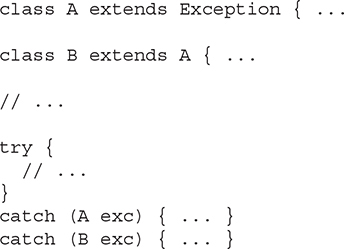
In the fragment, a superclass catch precedes a subclass catch. Since the superclass catch will catch all subclasses too, unreachable code is created.
6. Can an inner catch rethrow an exception to an outer catch?
Yes, an exception can be rethrown.
7. The finally block is the last bit of code executed before your program ends. True or False? Explain your answer.
False. The finally block is the code executed when a try block ends.
8. What type of exceptions must be explicitly declared in a throws clause of a method?
All exceptions except those of type RuntimeException and Error must be declared in a throws clause.
9. What is wrong with this fragment?

MyClass does not extend Throwable. Only subclasses of Throwable can be thrown by throw.
10. In question 3 of the Chapter 6 Self Test, you created a Stack class. Add custom exceptions to your class that report stack full and stack empty conditions.
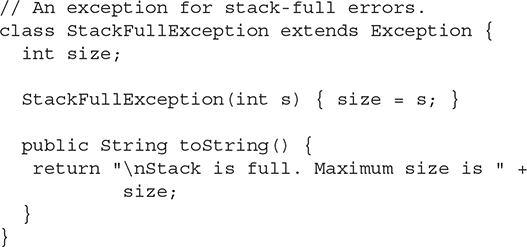
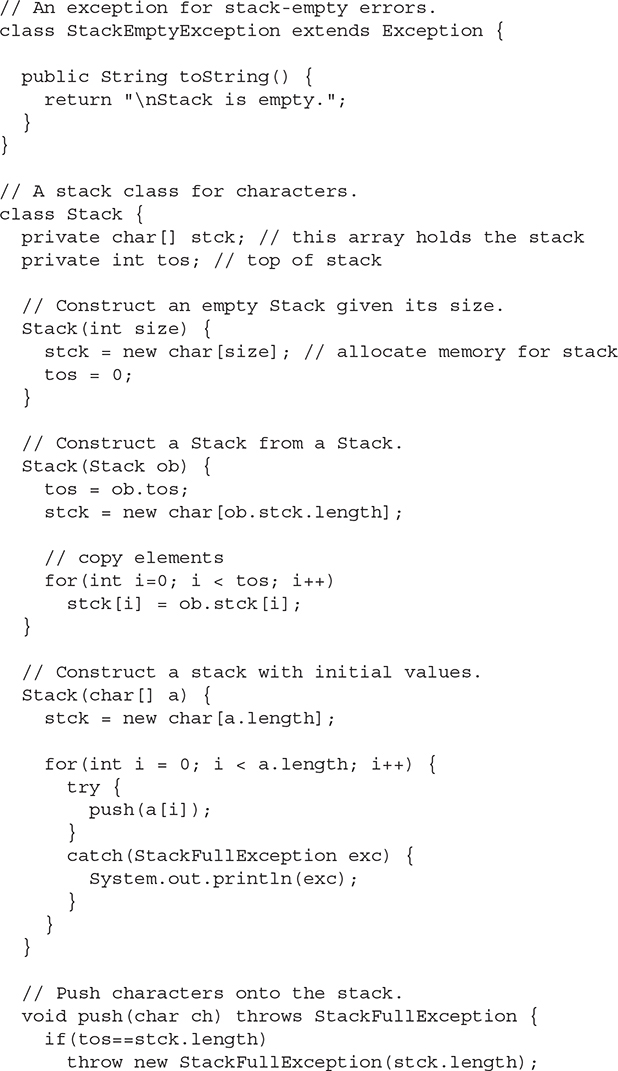
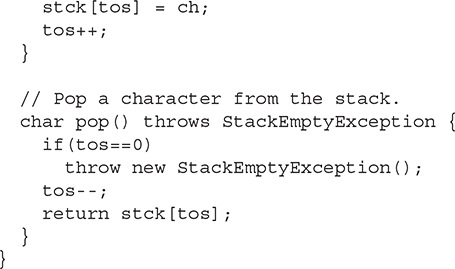
11. What are the three ways that an exception can be generated?
An exception can be generated by an error in the JVM, by an error in your program, or explicitly via a throw statement.
12. What are the two direct subclasses of Throwable?
Error and Exception
13. What is the multi-catch feature?
The multi-catch feature allows one catch clause to catch two or more exceptions.
14. Should your code typically catch exceptions of type Error?
No.
Chapter 10: Using I/O
1. Why does Java define both byte and character streams?
The byte streams are the original streams defined by Java. They are especially useful for binary I/O, and they support random-access files. The character streams are optimized for Unicode.
2. Even though console input and output is text-based, why does Java still use byte streams for this purpose?
The predefined streams, System.in, System.out, and System.err, were defined before Java added the character streams.
3. Show how to open a file for reading bytes.
Here is one way to open a file for byte input:
![]()
4. Show how to open a file for reading characters.
Here is one way to open a file for reading characters:
![]()
5. Show how to open a file for random-access I/O.
Here is one way to open a file for random access:
![]()
6. How do you convert a numeric string such as "123.23" into its binary equivalent?
To convert numeric strings into their binary equivalents, use the parsing methods defined by the type wrappers, such as Integer or Double.
7. Write a program that copies a text file. In the process, have it convert all spaces into hyphens. Use the byte stream file classes. Use the traditional approach to closing a file by explicitly calling close( ).
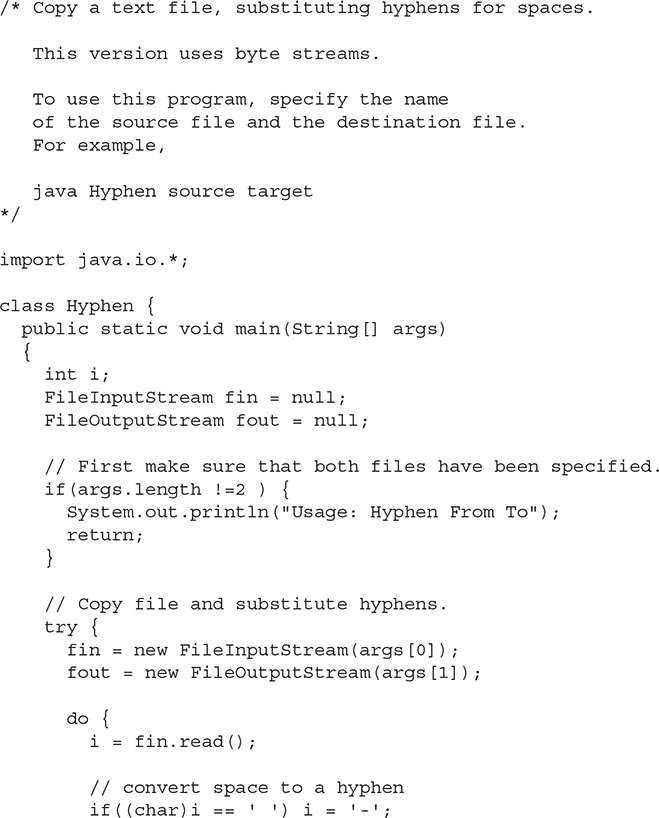
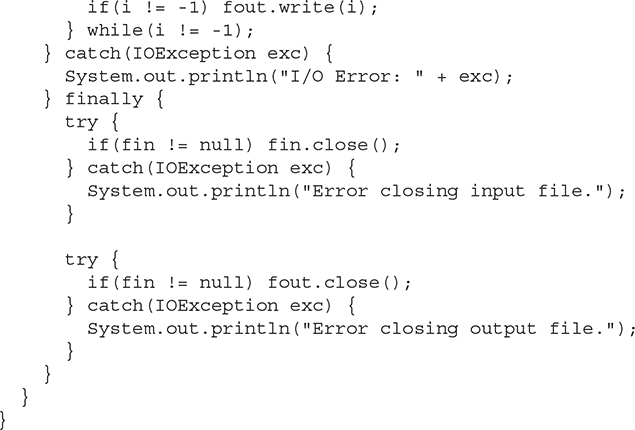
8. Rewrite the program in question 7 so that it uses the character stream classes. This time, use the try-with-resources statement to automatically close the file.
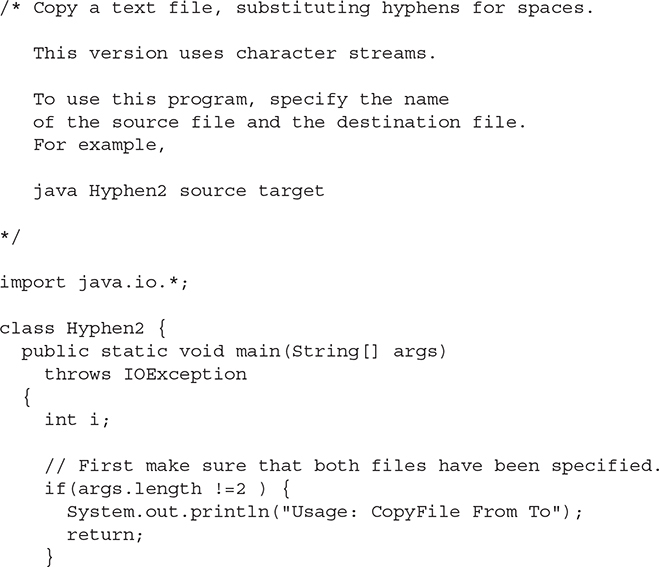
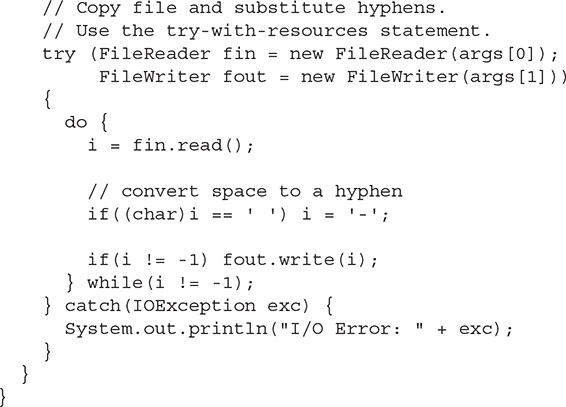
9. What type of stream is System.in?
InputStream
10. What does the read( ) method of InputStream return when an attempt is made to read at the end of the stream?
−1
11. What type of stream is used to read binary data?
DataInputStream
12. Reader and Writer are at the top of the ____________ class hierarchies.
character-based I/O
13. The try-with-resources statement is used for ___________ ____________ ____________.
automatic resource management
14. If you are using the traditional method of closing a file, then closing a file within a finally block is generally a good approach. True or False?
True
15. Can local variable type inference be used when declaring the resource in a try-with-resources statement?
Yes.
Chapter 11: Multithreaded Programming
1. How does Java’s multithreading capability enable you to write more efficient programs?
Multithreading allows you to take advantage of the idle time that is present in nearly all programs. When one thread can’t run, another can. In multicore systems, two or more threads can execute simultaneously.
2. Multithreading is supported by the __________ class and the __________ interface.
Multithreading is supported by the Thread class and the Runnable interface.
3. When creating a runnable object, why might you want to extend Thread rather than implement Runnable?
You will extend Thread when you want to override one or more of Thread’s methods other than run( ).
4. Show how to use join( ) to wait for a thread object called MyThrd to end.
MyThrd.join();
5. Show how to set a thread called MyThrd to three levels above normal priority.
MyThrd.setPriority(Thread.NORM_PRIORITY+3);
6. What is the effect of adding the synchronized keyword to a method?
Adding synchronized to a method allows only one thread at a time to use the method for any given object of its class.
7. The wait( ) and notify( ) methods are used to perform ____________________.
interthread communication
8. Change the TickTock class so that it actually keeps time. That is, have each tick take one half second, and each tock take one half second. Thus, each tick-tock will take one second. (Don’t worry about the time it takes to switch tasks, etc.)
To make the TickTock class actually keep time, simply add calls to sleep( ), as shown here:
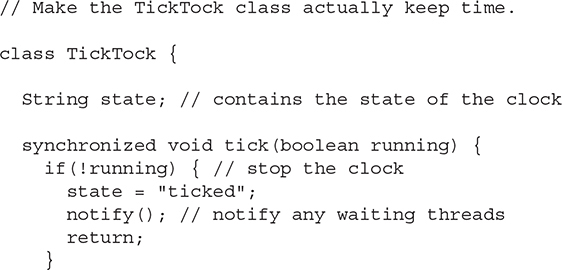

9. Why can’t you use suspend( ), resume( ), and stop( ) for new programs?
The suspend( ), resume( ), and stop( ) methods have been deprecated because they can cause serious run-time problems.
10. What method defined by Thread obtains the name of a thread?
getName( )
11. What does isAlive( ) return?
It returns true if the invoking thread is still running, and false if it has been terminated.
Chapter 12: Enumerations, Autoboxing, Annotations, and More
1. Enumeration constants are said to be self-typed. What does this mean?
In the term self-typed, the “self” refers to the type of the enumeration in which the constant is defined. Thus, an enumeration constant is an object of the enumeration of which it is a part.
2. What class do all enumerations automatically inherit?
The Enum class is automatically inherited by all enumerations.
3. Given the following enumeration, write a program that uses values( ) to show a list of the constants and their ordinal values.

4. The traffic light simulation developed in Try This 12-1 can be improved with a few simple changes that take advantage of an enumeration’s class features. In the version shown, the duration of each color was controlled by the TrafficLightSimulator class by hard-coding these values into the run( ) method. Change this so that the duration of each color is stored by the constants in the TrafficLightColor enumeration. To do this, you will need to add a constructor, a private instance variable, and a method called getDelay( ). After making these changes, what improvements do you see? On your own, can you think of other improvements? (Hint: Try using ordinal values to switch light colors rather than relying on a switch statement.)
The improved version of the traffic light simulation is shown here. There are two major improvements. First, a light’s delay is now linked with its enumeration value, which gives more structure to the code. Second, the run( ) method no longer needs to use a switch statement to determine the length of the delay. Instead, sleep( ) is passed tlc.getDelay( ), which causes the delay associated with the current color to be used automatically.

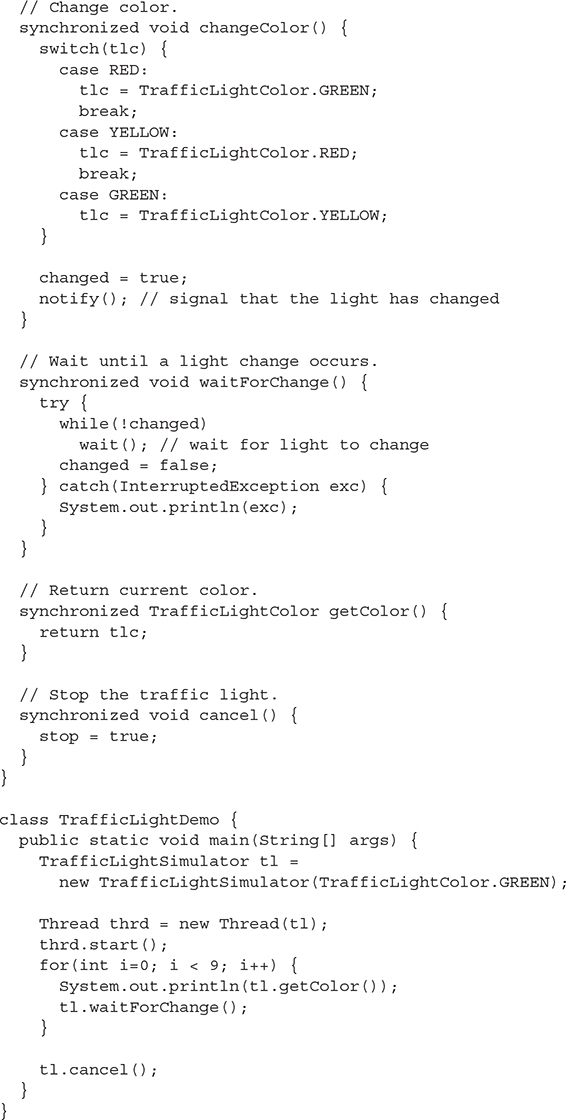
5. Define boxing and unboxing. How does autoboxing/unboxing affect these actions?
Boxing is the process of storing a primitive value in a type wrapper object. Unboxing is the process of retrieving the primitive value from the type wrapper. Autoboxing automatically boxes a primitive value without having to explicitly construct an object. Auto-unboxing automatically retrieves the primitive value from a type wrapper without having to explicitly call a method, such as intValue( ).
6. Change the following fragment so that it uses autoboxing.
![]()
The solution is
![]()
7. In your own words, what does static import do?
Static import brings into the current namespace the static members of a class or interface. This means that static members can be used without having to be qualified by their class or interface name.
8. What does this statement do?
![]()
The statement brings into the current namespace the parseInt( ) method of the type wrapper Integer.
9. Is static import designed for special-case situations, or is it good practice to bring all static members of all classes into view?
Static import is designed for special cases. Bringing many static members into view will lead to namespace collisions and destructure your code.
10. An annotation is syntactically based on a/an ________________ .
interface
11. What is a marker annotation?
A marker annotation is one that does not take arguments.
12. An annotation can be applied only to methods. True or False?
False. Any type of declaration can have an annotation. Beginning with JDK 8, a type use can also have an annotation.
13. What operator determines if an object is of a specified type?
instanceof
14. Will an invalid cast that occurs at run time result in an exception?
Yes
Chapter 13: Generics
1. Generics are important to Java because they enable the creation of code that is
A. Type-safe
B. Reusable
C. Reliable
D. All of the above
D. All of the above
2. Can a primitive type be used as a type argument?
No, type arguments must be object types.
3. Show how to declare a class called FlightSched that takes two generic parameters.
The solution is
![]()
4. Beginning with your answer to question 3, change FlightSched’s second type parameter so that it must extend Thread.
The solution is
![]()
5. Now, change FlightSched so that its second type parameter must be a subclass of its first type parameter.
The solution is
![]()
6. As it relates to generics, what is the ? and what does it do?
The ? is the wildcard argument. It matches any valid type.
7. Can the wildcard argument be bounded?
Yes, a wildcard can have either an upper or lower bound.
8. A generic method called MyGen( ) has one type parameter. Furthermore, MyGen( ) has one parameter whose type is that of the type parameter. It also returns an object of that type parameter. Show how to declare MyGen( ).
The solution is
![]()
9. Given this generic interface
![]()
show the declaration of a class called MyClass that implements IGenIF.
The solution is
![]()
10. Given a generic class called Counter<T>, show how to create an object of its raw type.
To obtain Counter<T>’s raw type, simply use its name without any type specification, as shown here:
![]()
11. Do type parameters exist at run time?
No. All type parameters are erased during compilation, and appropriate casts are substituted. This process is called erasure.
12. Convert your solution to question 10 of the Self Test for Chapter 9 so that it is generic. In the process, create a stack interface called IGenStack that generically defines the operations push( ) and pop( ).
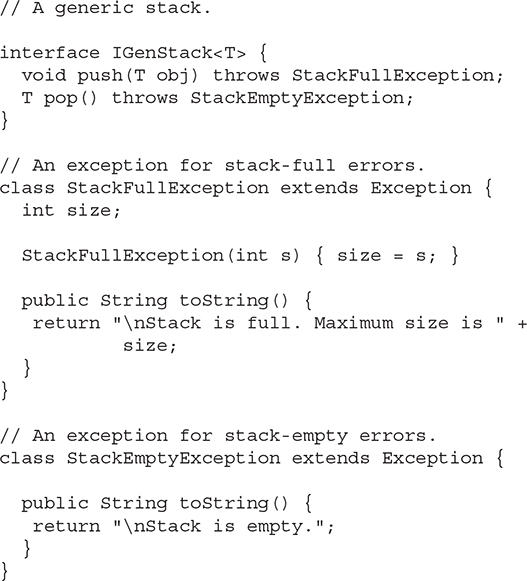
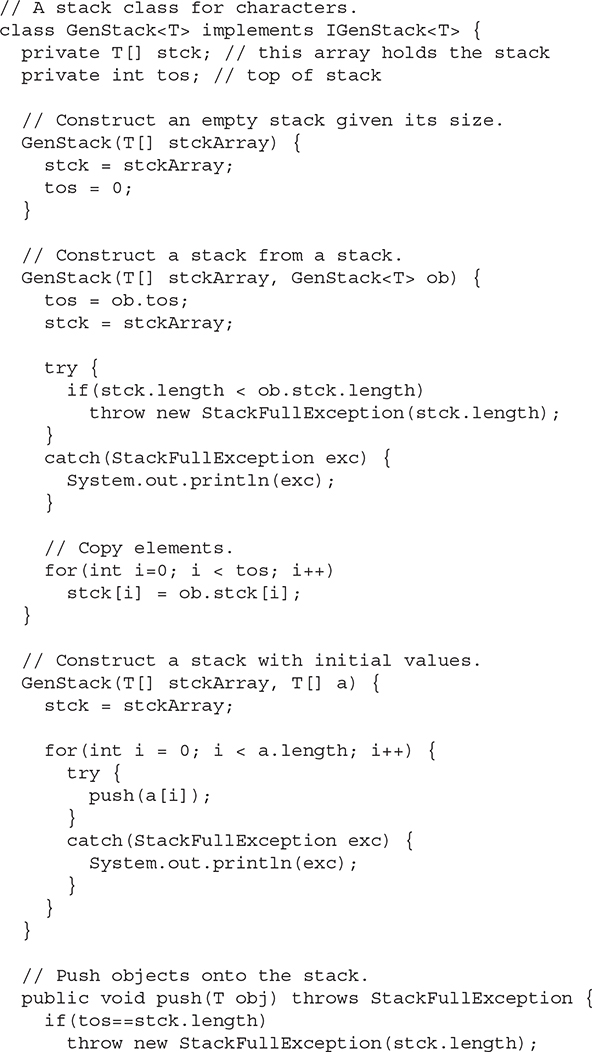
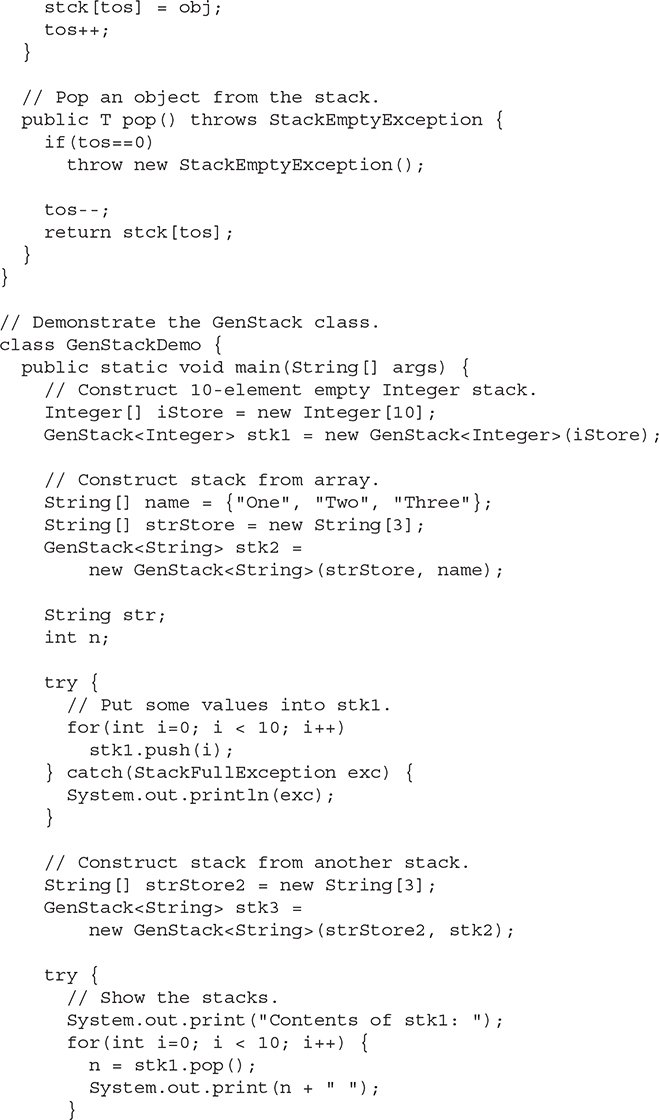

13. What is < >?
The diamond operator.
14. How can the following be simplified?
![]()
It can be simplified by use of the diamond operator as shown here:
![]()
Assuming a local variable declaration and beginning with JDK 10, it can also be simplified by use of local variable type inference, like this:
![]()
Chapter 14: Lambda Expressions and Method References
1. What is the lambda operator?
The lambda operator is −>.
2. What is a functional interface?
A functional interface is an interface that contains one and only one abstract method.
3. How do functional interfaces and lambda expressions relate?
A lambda expression provides the implementation for the abstract method defined by the functional interface. The functional interface defines the target type.
4. What are the two general types of lambda expressions?
The two types of lambda expressions are expression lambdas and block lambdas. An expression lambda specifies a single expression, whose value is returned by the lambda. A block lambda contains a block of code. Its value is specified by a return statement.
5. Show a lambda expression that returns true if a number is between 10 and 20, inclusive.
![]()
6. Create a functional interface that can support the lambda expression you created in question 5. Call the interface MyTest and its abstract method testing( ).

7. Create a block lambda that computes the factorial of an integer value. Demonstrate its use. Use NumericFunc, shown in this chapter, for the functional interface.
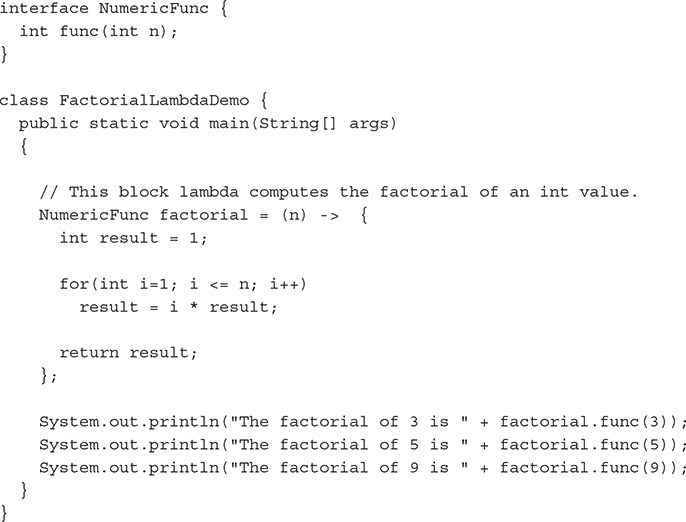
8. Create a generic functional interface called MyFunc<T>. Call its abstract method func( ). Have func( ) return a reference of type T. Have it take a parameter of type T. (Thus, MyFunc will be a generic version of NumericFunc shown in the chapter.) Demonstrate its use by rewriting your answer to 7 so it uses MyFunc<T> rather than NumericFunc.

9. Using the program shown in Try This 14-1, create a lambda expression that removes all spaces from a string and returns the result. Demonstrate this method by passing it to changeStr( ).
Here is the lambda expression that removes spaces. It is used to initialize the remove reference variable.

Here is an example of its use:
outStr = changeStr(remove, inStr);
10. Can a lambda expression use a local variable? If so, what constraint must be met?
Yes, but the variable must be effectively final.
11. If a lambda expression throws a checked exception, the abstract method in the functional interface must have a throws clause that includes that exception. True or False?
True
12. What is a method reference?
A method reference is a way to refer to a method without executing it.
13. When evaluated, a method reference creates an instance of the ____________ ___________ supplied by its target context.
functional interface
14. Given a class called MyClass that contains a static method called myStaticMethod( ), show how to specify a method reference to myStaticMethod( ).
![]()
15. Given a class called MyClass that contains an instance method called myInstMethod( ) and assuming an object of MyClass called mcObj, show how to create a method reference to myInstMethod( ) on mcObj.
![]()
16. To the MethodRefDemo2 program, add a new method to MyIntNum called hasCommonFactor( ). Have it return true if its int argument and the value stored in the invoking MyIntNum object have at least one factor in common. For example, 9 and 12 have a common factor, which is 3, but 9 and 16 have no common factor. Demonstrate hasCommonFactor( ) via a method reference.
Here is MyIntNum with the hasCommonFactor( ) method added:
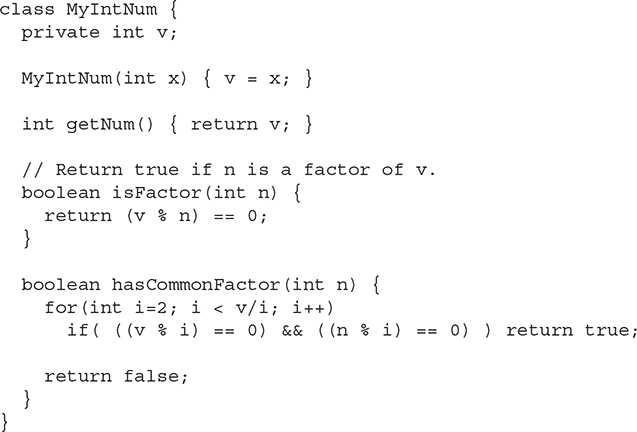
Here is an example of its use through a method reference:

17. How is a constructor reference specified?
A constructor reference is created by specifying the class name followed by :: followed by new. For example, MyClass::new.
18. Java defines several predefined functional interfaces in what package?
java.util.function
Chapter 15: Modules
1. In general terms, modules give you a way to specify when one unit of code depends on another. True or False?
True
2. A module is declared using what keyword?
module
3. The keywords that support modules are context sensitive. Explain what this means.
A context-sensitive keyword is recognized as a keyword only in specific situations that relate to its use and not elsewhere. As it relates to the module keywords, they are recognized as keywords only within a module declaration.
4. What is module-info.java and why is it important?
A module-info.java file contains a module declaration.
5. To declare that one module depends on another module, what keyword do you use?
requires
6. To make the public members of a package accessible outside the module in which it is contained, it must be specified in an _________ statement.
exports
7. When compiling or running a module-based application, why is the module path important?
The module path specifies where the modules for the application will be found.
8. What does requires transitive do?
By using requires transitive you enable one module to pass along its dependence on another module so that any module that relies on the current module also relies on the one specified in the requires transitive statement. This is called implied dependence or implied readability.
9. Does an exports statement export another module, or does it export a package?
An exports statement exports a package.
10. In the first module example, if you remove
![]()
from the appfuncs module-info file and then attempt to compile the program, what error do you see?
The compiler will report that the SimpleMathFuncs package does not exist. Since this package is required by MyModAppDemo, it will not compile.
11. Module-based services are supported by what keywords?
provides, uses, and with
12. A service specifies the general form of a unit of program functionality using either an interface or abstract class. True or False?
True
13. A service provider ____________ a service.
implements
14. To load a service, what class do you use?
ServiceLoader
15. Can a module dependency be made optional at run time? If so, how?
Yes, by using an exports static statement.
16. Briefly describe what open and opens do.
Modifying a module declaration with the keyword open enables access to its packages at run time, including by reflection, whether or not they have been exported. An opens statement enables run-time access to a package, including for the purposes of reflection.
Chapter 16: Switch Expressions, Records, and Other Recently Added Features
1. Rewrite the following sequence so that it uses a constant list:
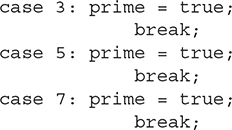
Here is the answer:
![]()
2. When using an arrow case, does execution fall through to the next case?
No.
3. Given this switch, show the yield statement that returns the value 98.6:

4. Assuming the switch in Question 3, show how to use an arrow case to yield the value 98.6.
![]()
5. Can you mix an arrow case and a colon case in the same switch?
No.
6. Can the target of an arrow case be a block?
Yes.
7. A record is commonly referred to as a/an __________ type.
aggregate
8. Given this record declaration, what are its components? What elements are implicitly created?
![]()
The components are highTemp, lowTemp, and location. Private final fields with the same names are implicitly created. Getter methods called highTemp( ), lowTemp( ), and location( ) are also implicitly created.
9. Does a record have a default constructor? If not, what type of constructor does a record automatically have?
No, a record does not have a default constructor. Instead, a record automatically defines a canonical constructor.
10. Given MyRec from Question 8, show the compact canonical constructor that removes leading and trailing spaces from the location string.

11. If you were to override a record getter method, in what way would you need to be very careful?
A record is immutable. Thus, to preserve the immutable semantics of a record, your getter must not return a value other than that contained in the record.
12. In Try This 13-1 you created a generic queue class. Can this class be used to store record objects without any changes? If so, demonstrate its use to store the Item records used in the Item record examples.
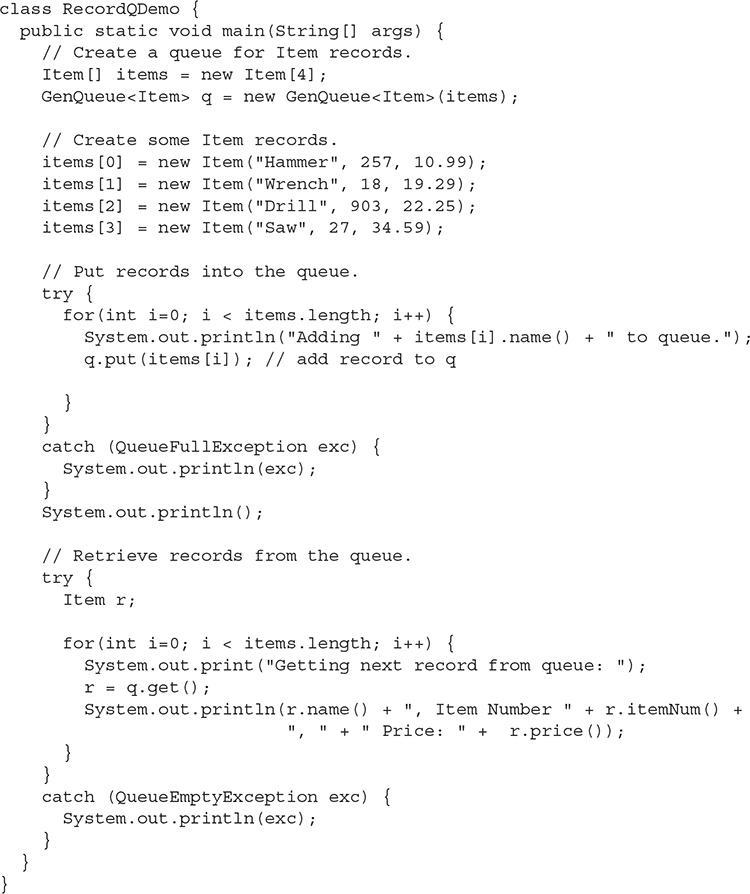
13. Rework the Item record so that the price component is generic, with an upper bound of Number.
![]()
14. In the BlockArrowCaseDemo program, the switch expression yields the shipping method, but the variable extraCharge is set separately inside each case. This program can be improved by having the switch yield a record that contains both the shipping method and the extraCharge value. In essence, the use of a record enables the switch to yield two or more values when it returns its result. Rework the BlockArrowCaseDemo program to demonstrate this approach.
Here is one way to code the improved BlockArrowCaseDemo program. It uses a record called ShippingInfo that holds both the shipping method and the extraCharge value.
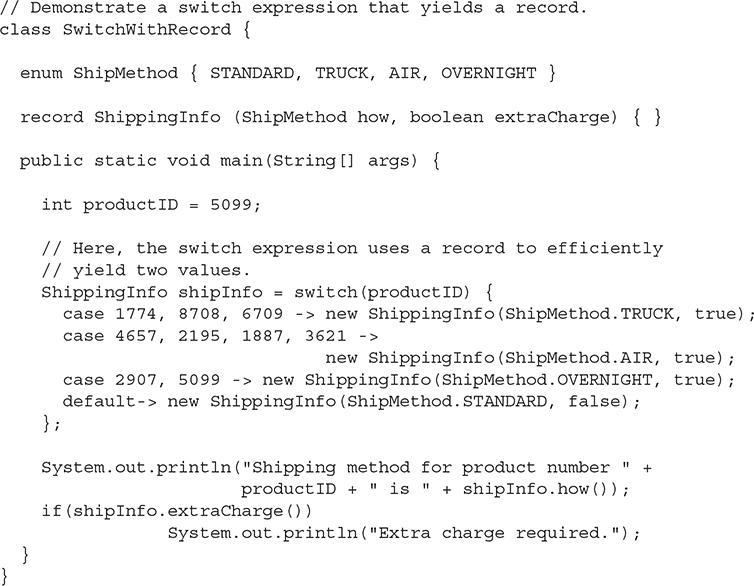
15. Show the general form of instanceOf when using pattern matching.
objref instanceof type pattern-var
16. Given:
![]()
fill in the blank in the following if statement that uses instanceof to determine whether myOb refers to a String.
![]()
17. A sealed class explicitly specifies the subclasses that can inherit it. True or false?
True.
18. Given the following:
![]()
which of the following declarations are legal?

Only A is legal. B does not extend MyClass. C needs to be modified by either final, sealed, or non-sealed. In D, SomeOtherClass is not permitted by MyClass.
19. Can an interface be sealed? If so, what effect does sealing an interface have?
Yes, an interface can be sealed. Only those interfaces that are listed in its permits clause can extend a sealed interface. Only those classes listed in its permits clause can implement the interface.
20. A preview feature is a new feature that is fully developed, but not yet formally part of Java. True or False?
True.
21. A preview feature is subject to change or may even be withdrawn. True or False?
True.
Chapter 17: Introducing Swing
1. In general, AWT components are heavyweight and Swing components are lightweight.
2. Can the look and feel of a Swing component be changed? If so, what feature enables this?
Yes. Swing’s pluggable look and feel is the feature that enables this.
3. What is the most commonly used top-level container for an application?
JFrame
4. Top-level containers have several panes. To what pane are components added?
Content pane
5. Show how to construct a label that contains the message "Select an entry from the list".
JLabel("Select an entry from the list")
6. All interaction with GUI components must take place on what thread?
event-dispatching thread
7. What is the default action command associated with a JButton? How can the action command be changed?
The default action command string is the text shown inside the button. It can be changed by calling setActionCommand( ).
8. What event is generated when a push button is pressed?
ActionEvent
9. Show how to create a text field that has 32 columns.
![]()
10. Can a JTextField have its action command set? If so, how?
Yes, by calling setActionCommand( ).
11. What Swing component creates a check box? What event is generated when a check box is selected or deselected?
JCheckBox creates a check box. An ItemEvent is generated when a check box is selected or deselected.
12. JList displays a list of items from which the user can select. True or False?
True
13. What event is generated when the user selects or deselects an item in a JList?
ListSelectionEvent
14. What method sets the selection mode of a JList? What method obtains the index of the first selected item?
15. Add a check box to the file comparer developed in Try This 17-1 that has the following text: Show position of mismatch. When this box is checked, have the program display the location of the first point in the files at which a mismatch occurs.
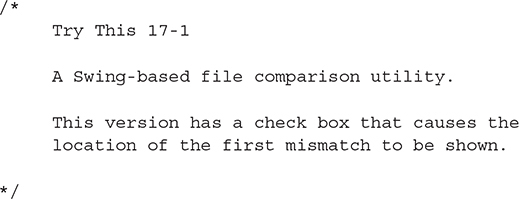
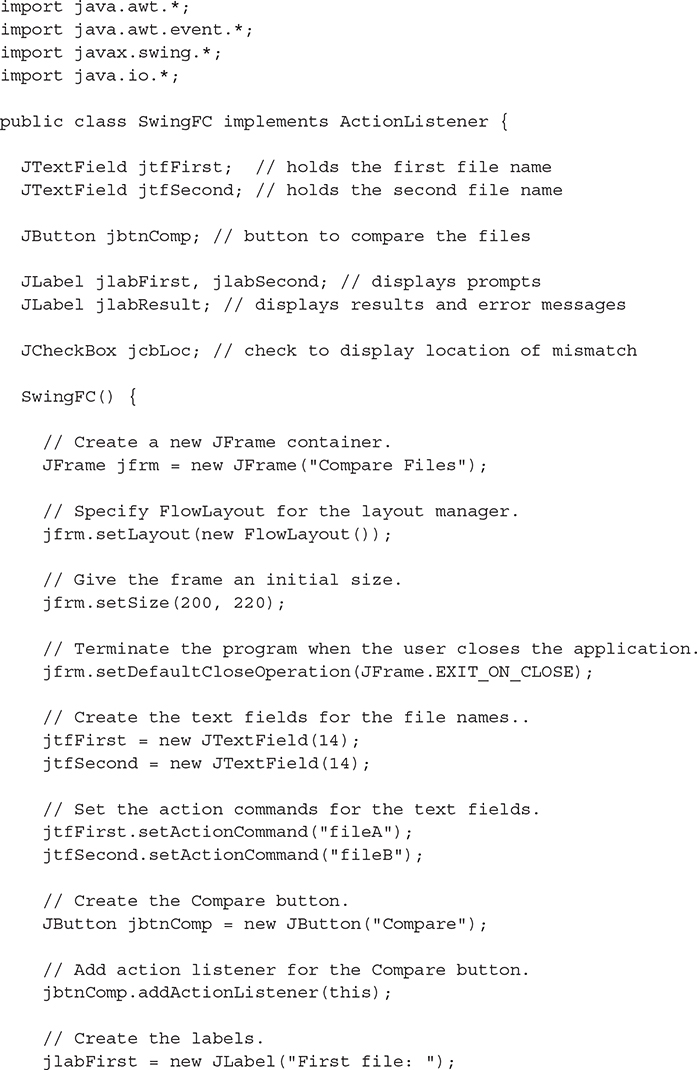
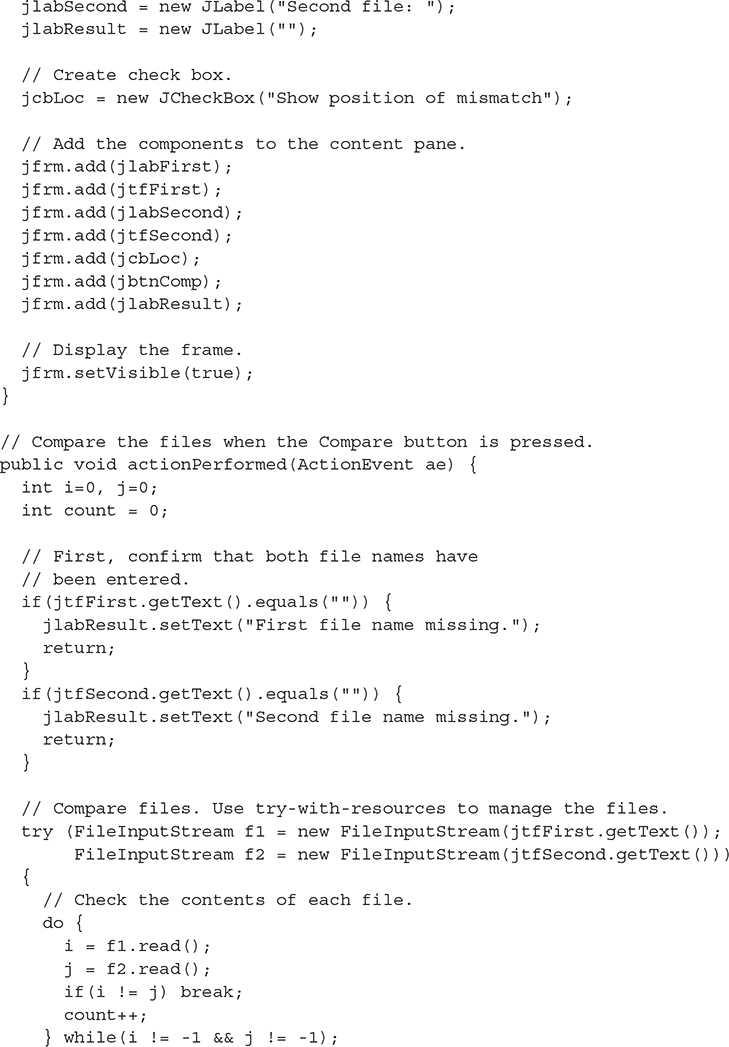
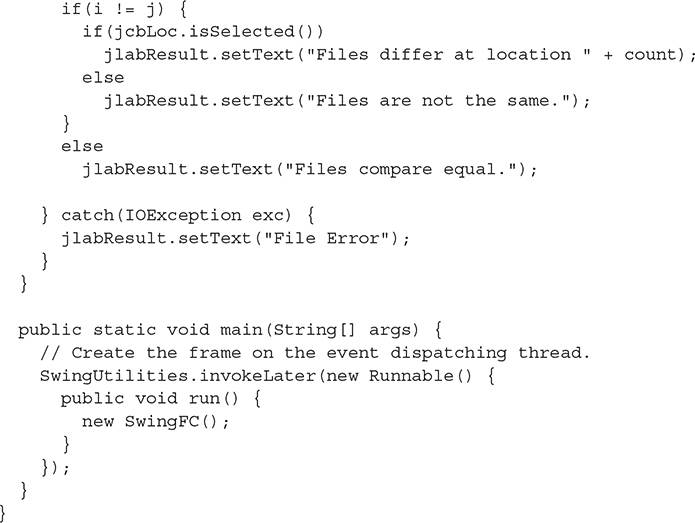
16. Change the ListDemo program so that it allows multiple items in the list to be selected.
